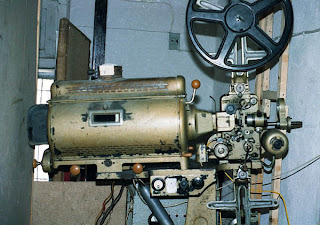 |
| A film projector, cheaper and can be used for decades . |
 |
| A typical digital projector, with an average usage of 5 years. |
Apparently, Rainbow Cinema and Hyland Cinema are the final cinemas in London, Ontario that still primarily use 35 mm film stock for their projectors, and the former is apparently the last in whole Rainbow Cinema/Magic Lantern chain to not make the transition that the film companies are forcing on the industry. However, the Hyland is an independent cinema and is not eligible for a corporate subsidy available to the chains to make the transition and now has to raise the $100,000 necessary for the projectors themselves through a public fundraising project. So, if you like great films that often no other cinema here shows in this city regularly, the Hyland needs your help now.
For myself, this is a bittersweet transition on top of the financial element. For one thing, there some actually upsides in this move. For one thing, Rainbow will be abandoning 3D projection once it makes the change and it can't happen too soon with nobody justifying the gimmick to me outside of DreamWorks Animation's great films like How to Train Your Dragon and Madagascar 3. In fact, that has been a selling point for Rainbow to have a haven where people can see a film "flat" and for a lower ticket price. Furthermore, there will be the advantage of not having to deal with the inevitable scratches and other signs wear and the threat of mishaps like film breaks and fouling.
However, this still seems a stupid move for the film companies themselves. Yes, they will save a bundle from striking prints and delivering them around, but they are still changing the fundamental nature of the experience. Digital projection is essentially a video projection, which makes the whole show essentially a something like DVD at home. In that case, when you make the viewing feel more like just like doing something you're already doing at home, the very point of going to the movie theater is diminished in the first place. When that happens, what's to prevent more people from just cutting out the middleman and wait for home video?
Essentially, all the movie theaters will have to compete against home viewing are newer films and a darkened room to see them without distractions. Yet, I go to the movie theater for the opportunity to get out of the house for something special and the cinemas will have to work harder to provide that and that's not having to deal with probable upgrades every 5 years while film projectors can last 30-40. That will raise prices itself on top of the expense of this transition and that will harm the industry more. If digital projection could allow to ease the delivery expense of content, then maybe that would be worth if they could combine more variety with other suggestions I've heard like bringing back film shorts as a regular part of the programming.
All this is not even accounting for other costs like the projectionists losing their jobs in favour of this glorified projection TV, leaving less chance of a skilled expert to handle the situation if something goes wrong. Then there is the problem of long term film preservation, the last use of film stock. On that issue, Pixar found itself learning the limits of digital data storage the hard way when it started working on Toy Story 3 and found that their old files of their character from Toy Story 2 were essential inaccessible because they were outmoded with their current tech and they had to start from scratch. When Pixar, the supreme masters of digital content gets caught short neglecting their own library storage like that, imagine what librarians and archivists have to deal with on far lower budgets? It worries me that how our films could run a risk of having to be reproduced ala kinescope: filming the content from a video display with a huge loss of picture quality like TV producers had to do before videotape. That is a terrible step back we don't need.
I know the film theaters don't have any choice about this, but this is still a sad time for an industry and for its viewers in the long run.
3 comments:
Wow, surprisingly I never knew this. I have been reading your blog a lot over the past few days and it has earned a place in my bookmarks.Thanks for sharing with us.
Post a Comment